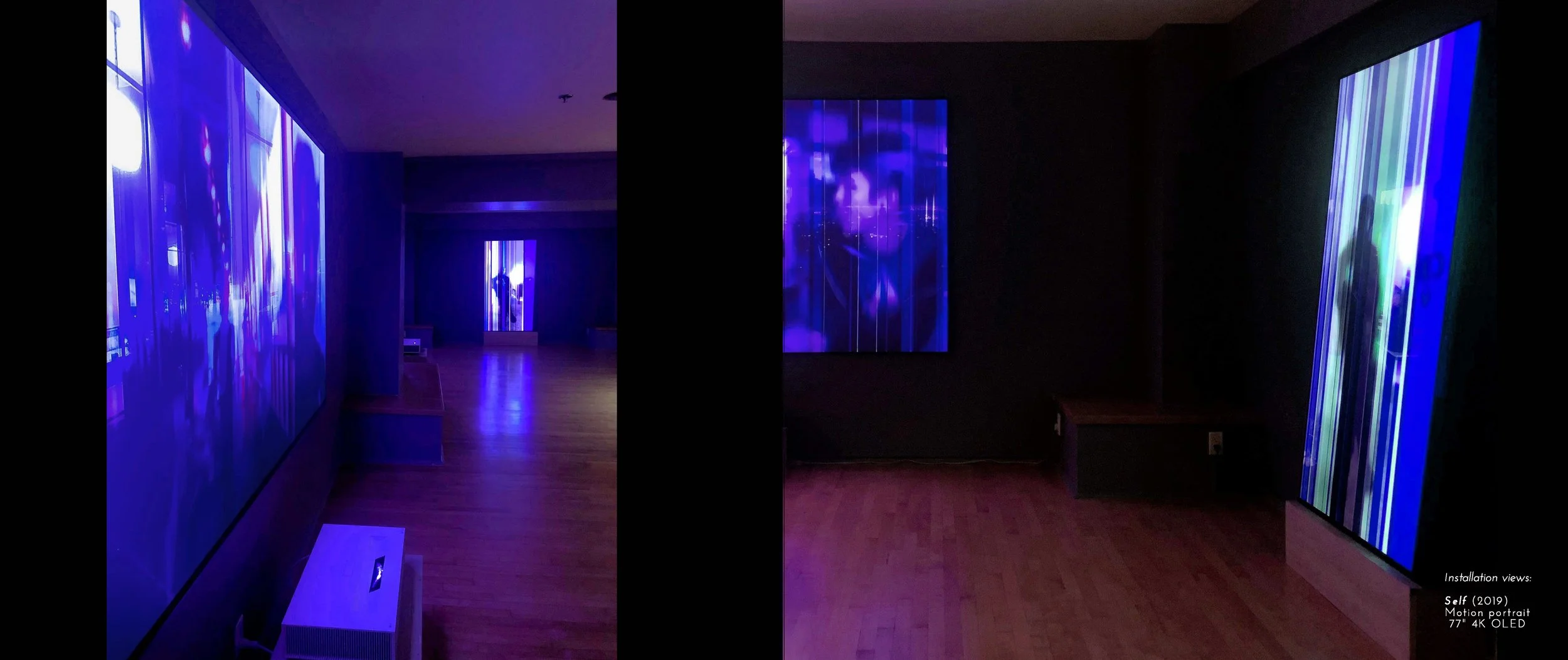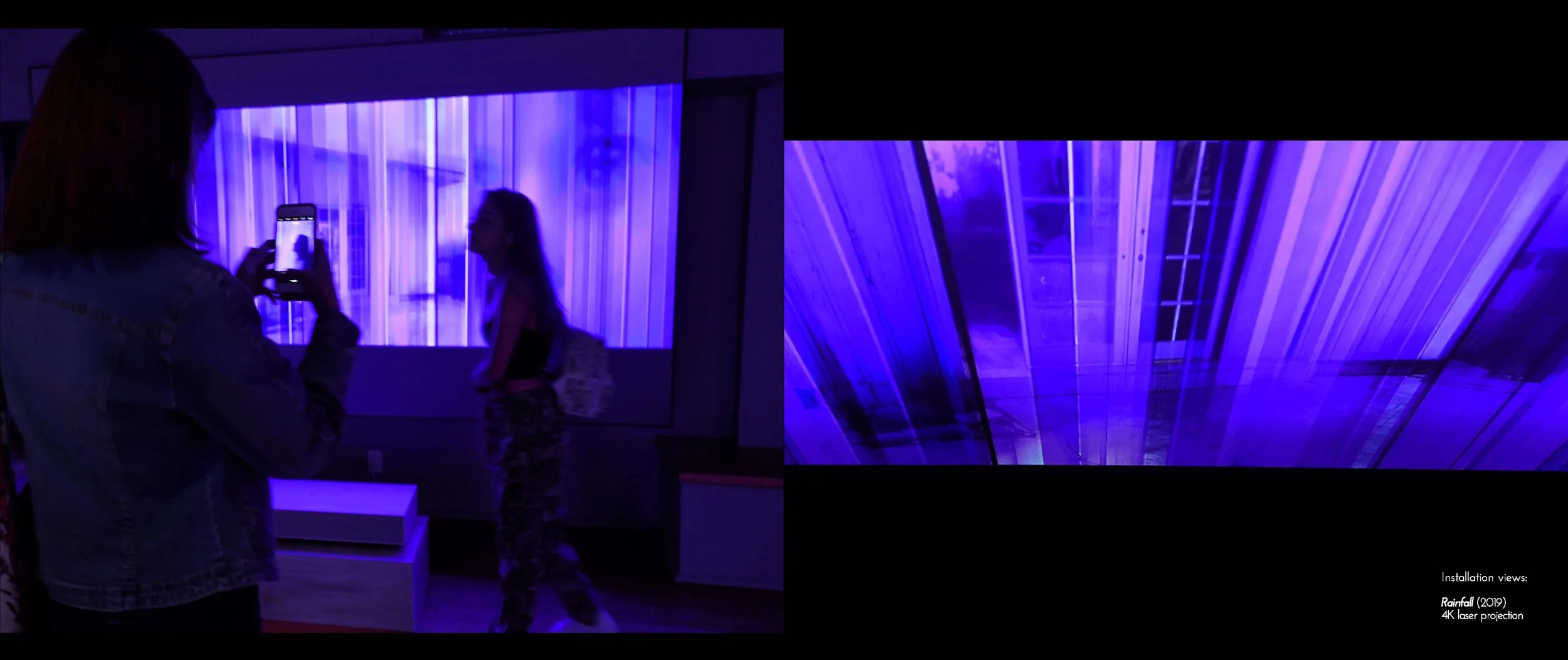| SELECTION OF SOUND AND MOTION WORKS
“I started my first sound and motion pieces after recovery, when I came across a family album. I realized that I was almost the last surviving member of my family, and that realization led to an exploration of time and memory. I wanted to know, if we're the sum of what we remember, then what happens when we begin to forget? And that question provoked four years of work — and the recognition that reality is unstable, fractured, stitched together to create order from chaos."
12E | 2019
Combining Super-8 footage which the artist shot in New York in 1974 with video and photographs of present-day Los Angeles, 12E compresses past and present in a continuum of shifting sound and motion. Merging childhood memory with images from the everyday world, Van Eyssen explores impermanence — and the narratives that exist for each of us in a personal quadrant of time and space.
Rainfall | 2019
A triptych from two different time periods — Los Angeles in 2019, and London, thirty years earlier, Rainfall suggests that time is compressed. As the empty house takes center stage, lit by strikes of lightning, we are tempted to psychologize the condition of the two boys at either side, but the dream logic of the piece ultimately resists convenient interpretation.
Mother | 2019
A two-screen study of a woman’s face as reconstituted by the process of remembering. Interference patterns and the use of adjacent color values throughout the work create an ethereal image that appears to fade and materialize.
Self | 2020
Conflating images taken on Ireland’s west coast and in Los Angeles, Van Eyssen’s Self is both a portrait of the artist and the acknowledgment that the story we construct around identity is fractured, fluid, and subject to the same disintegrating forces as the narratives we construct around others. Auto-photographic images with the subject holding the camera, like those in Self, began when Van Eyssen documented his experiences during medical treatment — as he says, “The self-portraits taken at that time were a kind of psychological insurance… proof that I still existed."
And Then I Saw You Green | 2020
What began as the final section of a four work series about the human relationship to the environment took an unexpected direction in the early months of the pandemic. "I began this piece in 2020. The abrupt loss of a close friend and, a week later, the eruption of social justice protests in Los Angeles, framed a dark season. Several weeks ago, I found myself paring the imagery back, removing anything that felt extraneous. The result is a more acute exploration of memory, and its seductive influence on the past… and a heightened sense of renewal and rebirth.”
They Drive At Night | 2021
4K sound and motion work that examines the the ambiguity of measured time — and the circularity of past, present, and future. Repeatedly, a car travels backwards and forwards along a hillside road at night, gradually creating a continuous stream of light that bisects the mountain’s silhouette.
With modified audio of Uranus' electromagnetic field recorded from Voyager.
And Then The Tide Runs Out | 2021
This single panel video work, which is part self-portrait, offers a meditation on climate change, and questions the relationship of the observer to the environment. Figures dance on the beachfront, or gaze passively from a chair, as a California sunset, or sunrise, drenches the scene in apocalyptic tones, and the tide rolls backwards, out to sea. Accompanying the moving image is a recording of a freeway, punctuated by fading signals from an echocardiogram.
A Martian Sends A Postcard Home | 2022
An 8K dual screen, sound and motion work that contemplates mortality, and the mystery of time. Occupying the central panel, an elderly figure (joined intermittently by the artist) reminisces — oblivious to the arrival and departure of public transportation, cars passing, shadow figures crossing stations and empty fields, and the silhouette of a forest emerging from the wallpaper behind him.
Published in 1977, Craig Raine’s poem, A Martian Sends A Postcard Home, imagines the world from the detached perspective of an alien visitor — human behavior, and the objects that populate our world, observed as strange and puzzling phenomena.
Encounter | 2024
A 4K single-screen linear interpretation of the mixed reality installation exhibited at MOCA London.
“Van Eyssen started by creating a series of scans of damaged cars in body shops across Los Angeles. He then digitally stitched the scans together. Later he scanned two professional models, dressed in suits, against green screen in his studio, which were then added to the scene. The tragic drivers appear to be caught in an embrace above the twisted metal. Van Eyssen then added reflective spheres and animated shards of glass to the overall digital sculpture which is over 26 feet long.
Most visitors will be confounded by the experience. The crash is visceral and hits you hard as the metal that crumples before your eyes. The flying glass looks sharp enough to cut you, and you have to duck around the work to completely see and understand how it works in the room. It is very easy to suspend disbelief and walk around the empty gallery as if it were the scene of a violent accident. The suspended embrace is touching, and for a digital work it is amazingly human and humane.” — From Dr. Michael Petry’s catalogue essay


















